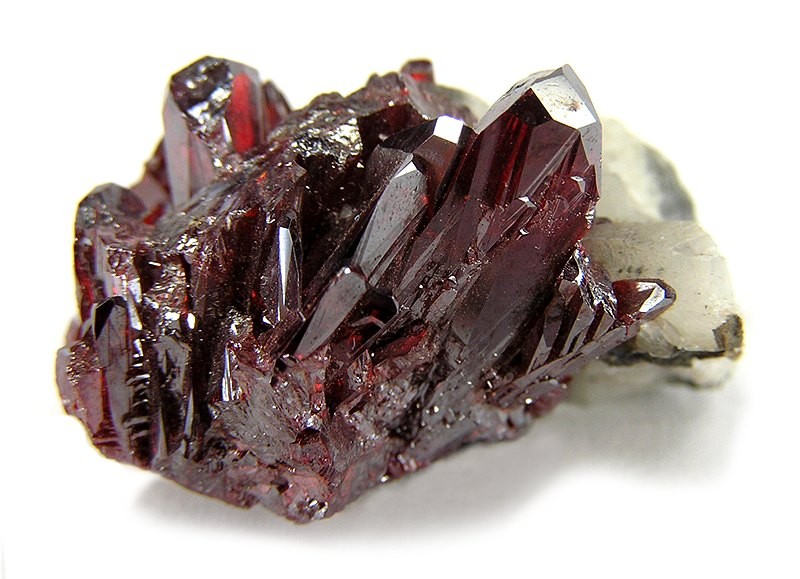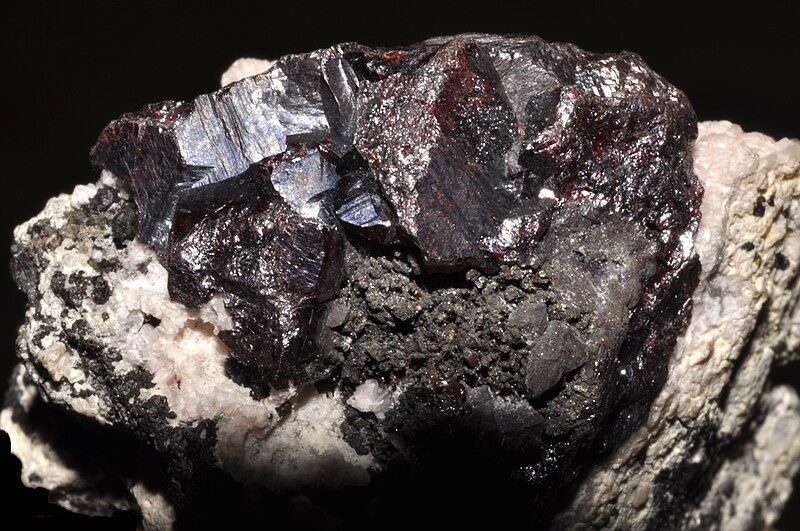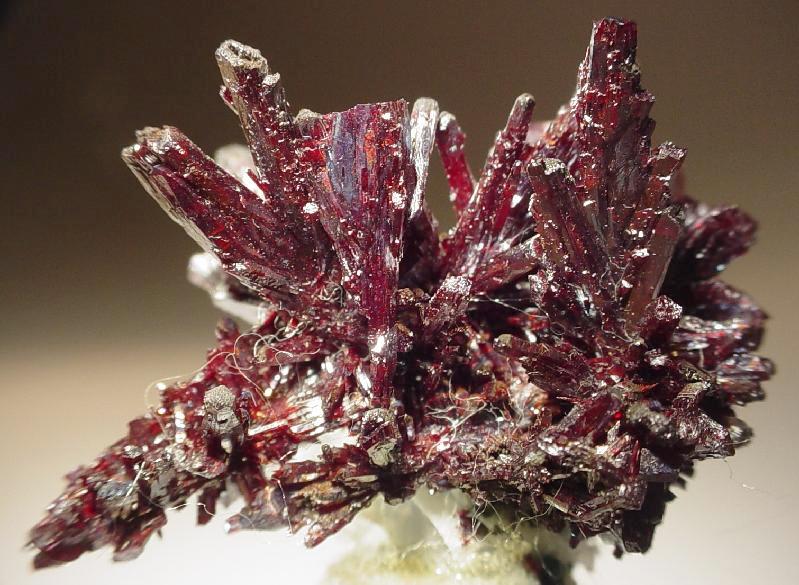
Proustite Gemstone: Properties, Meanings, Value & More
 Proustite is a scarlet red gemstone known as a significant metal ore. What is proustite an ore of? Silver!
Proustite is a scarlet red gemstone known as a significant metal ore. What is proustite an ore of? Silver!
Is proustite a mineral? Yep, proustite is a silver arsenic sulfide mineral.
Is proustite rare? Definitely. Silver is already rarely a native element in minerals. Silver minerals are also rarely faceted and rarely attractive, making the ruby-red proustite sought-after by collectors.
Today, we’ll cover proustite’s gemstone and mineral properties, meanings, history, prices, and more!
 Image credit: Rob Lavinsky, iRocks.com – CC-BY-SA-3.0
Image credit: Rob Lavinsky, iRocks.com – CC-BY-SA-3.0
What is Proustite?
Proustite is a rare semi-precious gemstone with deep scarlet hues. Astrologically, proustite benefits Sagittarius.
Nicknames for proustite include:
Ruby silver
Ruby silver ore
Light red silver
Light red silver ore
Light ruby silver ore
Red silver ore
Arsenical red silver
Arsenical silver blende
Sangre de torro (Spanish for “blood of the bull”)
Note: Proustite’s “ruby” nicknames are only referencing its color; ruby is a separate mineral.
Obviously, proustite is a silver ore. But “ruby silver” can also refer to polybasite, pearceite, and pyrargyrite. Pyrargyrite is also called “dark red silver” or “dark red silver ore.”
On that note, what are the uses of proustite?
Proustite Uses
The predominant industrial use of proustite is as a source of silver. It’s not the most common silver ore today (that would be argentite), as it was more important historically, but it’s still a minor ore.
As of 2022, the top silver uses outside of jewelry and silverware were for electronics and electrical components (including solar energy), catalysts, and metal solders.
Additionally, proustite has been synthesized and studied for dye laser optical mixing.
 Image credit: Rob Lavinsky, iRocks.com – CC-BY-SA-3.0
Image credit: Rob Lavinsky, iRocks.com – CC-BY-SA-3.0
Proustite Specifications & Characteristics
The mineral proustite is composed of silver, sulfur, and arsenic. It’s classified as a sulfosalt mineral.
Proustite forms a series with silver antimony sulfide pyrargyrite. Though very similar, pyrargyrite is darker red with a purplish-red streak.
Pyrargyrite is in the proustite mineral group alongside xanthoconite and pyrostilpnite. Xanthoconite has the same composition as proustite but monoclinic crystal structure.
Proustite crystals are often horizontally striated. They can be prismatic, rhombohedral, and/or scalenohedral (twelve scalene triangle-shaped faces). Some prismatic crystals have one scalenohedral termination and one rhombohedral termination.
Twinning is common. Multiple proustite crystals can be found forming blocky groups, trillings (three crystals intergrown), or interpenetrating each other.
The proustite mineral can also occur in compact, encrusting, massive, grainy, botryoidal, or globular forms.
Proustite properties listed:
Mohs hardness: 2-2.5
Color: Shades of deep red (scarlet, vermilion, cherry), dark purplish- or violet-red, reddish-gray, gray, metallic gray
Crystal structure: Hexagonal (trigonal)
Luster: Adamantine or submetallic
Transparency: Translucent to opaque, rarely transparent; Can become more opaque over time
Refractive index: 2.792-3.088
Density: 5.51-5.64
Cleavage: Distinct/good on {1011}
Fracture: Conchoidal or uneven/irregular
Streak: Scarlet or vermilion red
Luminescence: None
Pleochroism: Present & moderate to strong in blood-red and scarlet
Birefringence: 0.295-0.296
Dispersion: Weak
Optical phenomena: Often irreversible photochromism
What’s that “irreversible photochromism” about?
 Image credit: Parent Géry, Public Domain
Image credit: Parent Géry, Public Domain
Proustite Changes Over Time
One of proustite’s notable (though unfortunate) qualities is photochromism.
Photochromism is when a mineral changes color from exposure to light. Unlike color-changing gems like alexandrite, photochromic gems only change color under UV light (like sunlight) and the shift happens at various rates, from minutes to hours after exposure.
Another important distinction is reversible photochromism (tenebrescence) vs irreversible photochromism. Tenebrescent stones (e.g. hackmanite) can change color back and forth indefinitely. Stones with irreversible photochromism (e.g. kunzite) permanently change color upon exposure.
Proustites containing silver have irreversible photochromism; light exposure will make them darker in color (eventually black) and more opaque. It can also cause a dull, dark film on the crystal’s surface, but you can remove the film with a simple cleaning.
Even without light exposure, proustites can still gradually darken over time. The reason is because the mineral’s silver atoms are somewhat free-flowing, so they can start forming another crystal inside: dark gray acanthite. Acanthite’s presence causes a gradual color-change.
All these changes are also present in pyrargyrite.
Spiritually, what is the meaning of proustite?
 Image credit: Rob Lavinsky, iRocks.com – CC-BY-SA-3.0
Image credit: Rob Lavinsky, iRocks.com – CC-BY-SA-3.0
Proustite Meaning & History
Proustite symbolizes strength, courage, and resilience. It can also represent intuition, self-awareness, and spiritual awakening.
Early History
French mineralogist and geologist François Sulpice Beudant named proustite in 1832 after French chemist Joseph L. Proust, who first identified and proved proustite as a distinct mineral from pyrargyrite.
Proustite’s type locality is Jáchymov in the Czech Republic, formerly called Sankt Joachimsthal or Joachimsthal until 1945. The town has a rich silver mining history.
Established in 1516, it became the second most populous town in Bohemia after Prague because of the abundance of silver.
Some silver mined there was minted into Joachimsthaler coins starting in 1520. The shortened form, thaler, eventually inspired the dollar.
Chile Discovery
Chilean farmer and miner Juan Godoy stumbled upon silver deposits in Chañarcillo, Chile, in 1832, kickstarting the Chilean silver rush.
Miners eventually found proustite and nicknamed it sangre de torro, meaning “blood of the bull,” as its host rock was “bleeding” with the silver ore.
Proustite Healing Properties
As a popular red healing stone, proustite has the energizing and motivating properties of other red gemstones, along with being an effective root chakra stone.
Physical Healing
Proustite’s metaphysical properties are said to include treating physical problems related to:
Prostate
Circulation
Infections
Kidney & bladder
Menopause
Emotional Healing
Emotionally, proustite is said to bring courage and insight into your true purpose. It may also attract abundance, facilitate inner peace, and provide emotional balance.
 Image credit: Maurizio Dini, CC-BY-SA-3.0
Image credit: Maurizio Dini, CC-BY-SA-3.0
Proustite Gemstone Properties
Besides rarity, proustite gem value depends on color, cut, clarity, transparency, and carat weight affect their value.
Color
Proustite colors are on the bright to deep red spectrum, sometimes with yellow or purple undertones. Specimens that have deteriorated (either from light exposure or time) are often black and not as valuable.
The cause of proustite’s color falls into the band theory of color origins, as it’s caused by medium band-gap semiconductors.
Cut
The stone’s rarity and softness make faceted proustites scarce. Most have rectangular step, round, or octagon shapes.
Most proustite for sale is available as rough (uncut) specimens.
Clarity & Transparency
Clarity, the degree of visible inclusions in a gem, can affect a stone’s transparency and value. Some proustites have internal fractures or growth zoning.
Inclusions are only visible in transparent specimens, however, which are already rare enough to be valuable regardless of clarity.
Carat Weight
Although proustite crystals currently in collections or displays could yield huge faceted gems, they probably won’t be cut any time soon. Some particularly large faceted proustites have been 10 to 12 carats.
Synthetics
Synthetic proustites are not only used in research but may also pop up as faceted stones in collections.
 Image credit: Rob Lavinsky, iRocks.com – CC-BY-SA-3.0
Image credit: Rob Lavinsky, iRocks.com – CC-BY-SA-3.0
Proustite Formation & Sources
Proustite forms in hydrothermal deposits as a low-temperature, late-phase mineral. It’s usually found in the oxidized zone (above the water table) or supergene zone (close to the surface).
Supergene mineral formation involves precipitation water going down into the ground, oxidizing primary sulfide minerals while forming sulfuric acid and oxidized metal solutions. These solutions travel further down into the oxidized zone where they can further react with primary minerals to create secondary minerals like proustite.
Geographically, where is proustite found?
Mining Locations
The best proustite crystals, and most facetable material, from Chile, especially Chañarcillo. The Czech Republic also remains a top source.
Other significant sources include:
Canada
Germany
France
Italy
Mexico
Peru
USA (California, Colorado, Idaho, Nevada)
 Image credit: Rob Lavinsky, iRocks.com – CC-BY-SA-3.0
Image credit: Rob Lavinsky, iRocks.com – CC-BY-SA-3.0
Proustite Price & Value
Proustite is rare as a mineral and gemstone, so its prices generally reflect that. However, faceted proustite gems are the priciest.
Faceted proustites range from around $200 to $1,200 per carat or about $700 to $1,900.
Specimens with red coloring cost more than those with only gray to black coloring.
Overall, gray specimens are usually around $30 to $90, while red specimens are about $150 to $700 or higher. The highest-quality collector specimens range from $2,500 to almost $10,800 each.
Proustite Care and Maintenance
First, it’s important to note that proustite contains arsenic, which is toxic if ingested. We have safety tips on handling toxic minerals, but the biggest tips here are:
Wear proper safety equipment if cutting or polishing proustite to avoid inhaling any proustite dust or fumes.
Wear gloves to handle proustite and dispose of the gloves afterwards or keep them in a designated box to avoid cross-contamination.
Keep the stone away from anyone who might put it in their mouth (e.g. children and pets).
Do not use proustite to make elixirs.
Proustite scratches easily, increasing the risk of it releasing arsenic-containing fibers. We recommend only keeping proustite in an enclosed display case.
In terms of gemstone care, it’s best to keep proustite in darkness (at a cool temperature) to maintain its transparency and coloring. Although many prostitutes will inevitably darken over time regardless, light exposure and heat quicken the process.
Wearing gloves, you can clean proustite with mild soap, water, and a soft microfiber cloth.
On the Prowl for Proustite?
Despite the number of minerals containing silver, all of them are rare. Proustite may seem like a scary mineral, but with the proper care, this gorgeous rarity is a dream for any collector.
Search the Gemstone Encyclopedia
Related Auctions
Related Articles
Originally the Birthstones or gemstones were associated with a zodiac sign or the month of a individuals birth. Find out what your stone is and view the stones we have for sale
8th Feb 2021
There are dozens of quartz and chalcedony gems with various colors and patterns. Learn all about quartz properties and every type of quartz, from amethyst and agate to plasma and phantom quartz!
15th Oct 2020
Hackmanite is a pink to violet sodalite gem known for its unique color-change and luminescence. Learn why hackmanite is special, from its rare qualities to the types of hackmanite jewelry available.
28th Mar 2018
Latest Articles
Tantalite is a group of red, brown, or black minerals containing the rare and valuable element tantalum. Discover the uses, history, prices, and properties of tantalite gemstones in this guide!
11th Nov 2024
Hodgkinsonite is a very rare collector’s gemstone known for its vibrant pink or purple hues, only found in New Jersey, USA. Learn hodgkinsonite’s prices, history, properties, and traits in this guide!
9th Jun 2024
Canasite is a rare mineral usually found as greenish-yellow inclusions in charoite but also known as a purple gemstone. Learn canasite’s history, varieties, properties, and prices in this guide.
27th May 2024
Article Categories
How To's is where you will find helpful articles from gem Rock Auctions on how to cut gemstones, select gemstones and buy gemstones.
9 Articles




